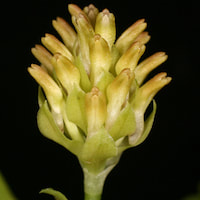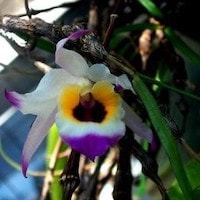Click for other Women's Fresh 1, Fresh 2, Fresh 3, Fresh 4, Fresh 5, Fresh 6, Fresh 7, Fresh 8, Fresh 9, Fresh 10, Fresh 11, Fresh 12
Contains Scented Notes of:
Grass - Check details at Scentopia's scent library
Native Singaporean Orchid notes: Vrydagzynea albida
|
Vrydagzynea albida - Used in Fresh 5 (Women) for Team building Perfume workshop
Found in lower montane tropical rainforests along stream banks in dark and damp places with creeping rhizomes. It has erect stems, carrying 6 to 8, spaced out leaves that blooms in the late spring through early fall. They have many flowered, pubescent inflorescence with few to many at a time, sequentially opening flowers all held in an apical corymb. While the flowers seem to have little to no smell, the oil extracted has soft but delightful fragrance. |
Therapeutic Orchid notes:
|
Crepidium resupinatum (G. Forst.) Szlach. Syn. Seidenfia rheedii (Sw.) Szlach. (see Liparis rheedii Sw.); Seidenfia versicolor Marg. & Szlach.
Phytochemistry: Pseudobulb of C. acuminatum contains an alkaloid, glycosides, flavonoids, beta sitosterol, piperitone, 0-methylbatatasin, 1,8-cineole, citroenelal, euge- nol, glucose, rhamnose, coline, limonene, p- cymene and ceryl alcohol. An alkaloid, grandifoline, isolated from this orchid is a glycosidic derivative of nervogenic acid esterified with laburnine. Pseudobulb extracts of C. acuminatum contain polyphenols which possess antioxidant activity. Herbal Usage: In the western part of the Indian peninsula, a potion made with the plant is used to treat fever, biliousness and infantile epilepsy. |
|
Dendrobium falconeri Hook.f. syn Dendrobium erythroglossum Hayata
Chinese names: Xinzhushihu (Xinzhu noble Dendrobium), Honglishihu (red crane Dendrobium); Chuanzhushihu (string Dendrobium), and in Taiwan: red oriole Dendrobium Taiwanese name: Xin Zhu Shi Hu (new bamboo Dendrobium) Thai Names: Ueang sai wisut, Rot rueang saeng, Ueang mieng, ueang ya phaet. A magnificent Dendrobium with pendulous, terete, long, slender, branched and knotted stems. D. falconeri reduced protein levels of migrating human lung cancer H460 cells in a dose- dependent manner. Usage: TCM states that stem nourishes the yin elements, benefits the stomach, stops thirst and relieves the feeling of heat, dry mouth and dry throat. It is used to treat people recovering from illness or who are suffering from anorexia. |
|
Epipactis papillosa Franch et Sav.
Chinese name: Ximaohuoshao Lan (fine fur flaming orchid) Chinese medicinal names: Jisuzihua (cockerel crop flower); Niushepian (slice of a cow’s tongue) Usage: In India, the stems and rhizomes were employed to treat insanity. The entire plant is used in Chinese herbal medicine to strengthen the “middle burner” and replenish qi after a spate of illness, and also to treat cholera, testicular swelling and hernia. |
|
Grammatophyllum speciosum Blume
Common name: Tiger Orchid Indonesian names; Anggkrek tebu (Malay) (sugar cane orchid); Angkrek tiwu (sugar cane orchid), Kadaka susuru (Sundanese) Malay names: Bunga puteri (Princess flower); Bunga bidadari (nymph’s flower) Thai name: Wan phetchahueng Myanmar name: Kyar ba hone Philippine names: Giant Orchid, Queen Orchid, Sugar-cane Orchid The species is distributed in Burma, Thailand, Laos, Malaysia, Singapore, Indonesia, the Philippine, and Papua New Guinea in the lowlands. In Singapore, it flowers from August to September. Mr. Ridley noted that plants had to reach a large size before they will flower but afterwards they would flower every year. Plants grow very well in Penang in northern Malaysia which has a similar long dry season from November to February. Herbal Usage: The stem of is used to treat fever and anaemia in Thailand. Roots are listed as an insect bite remedy in old Thai drug recipes. Kelabit in Sarawak use the orchid stems (ubud aram) as food, although it is slightly bitter when cooked. |
|
Phalaenopsis wilsonii Rolfe
Chinese names: Die Lan (butterfly orchid), Huaxidie Lan (Western China butterfly orchid), Huaxihudie Lan (Western China moth orchid) Chinese medicinal name: Die lan A small Chinese species is found as an epiphyte on trees in sparse woods or as a lithophyte in shady spots along ravines in Yunnan, southeastern Xizang, western Guangxi, western Sichuan, southwestern Guizhou in China and in northern Vietnam. It does not get killed by bacterial rot, is immune to fungi, and it is not attacked by arthropods, snails and slugs . Leaves are used as a salad in Java. Phytochemistry: It is promising as a source of secondary metabolites because many alkaloids (17) were found. Most ofthem in excess of 0.1 % of total weight. Phalaenopsine is the major alkaloid (more than 90 % of the alkaloid content) and is present throughout the plant. This makes the extraction very easy. Two phenanthropyran derivatives have been isolated from P. equestris. They are 3-methoxy-2,7-dihydroxy-5H-phenanthro(4,5-bcd) pyran and 2,3,7-trihydroxy-5H-phenanthro (4,5-bcd)pyran. Naturally occurring pyrolizidine alkaloids from plants are generally poisonous and are known to cause fatalities in grazing cattle, and liver cirrhosis and cancer in humans. However, the pyrolizidine alkaloids present in orchids are thought to be non-toxic (International Program on Chemical Safety, WHO, 1988). Plant is used to treat headache in some countries. This is a very fragrant species. Geranyl diphosphate synthase is the precursor of monoterpenes, the major scent compound in strongly scented P. bellina. It also has geraniol and linalool. |
Other scent notes
Fresh clean cotton notes, green melon, Chamomile, Avocado, Grass, Water Hyacinth, Olive leaf, pear leaf, Sea water





